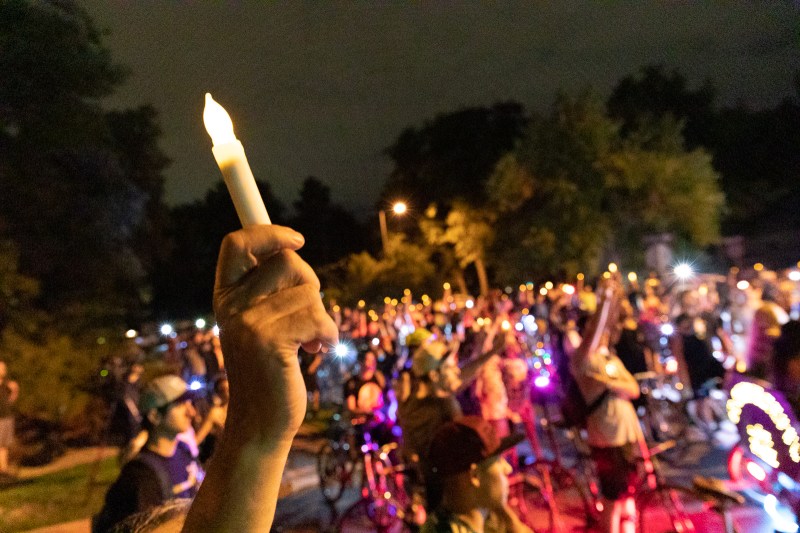Streetsblog in the Denver Post: To Save Lives, Denver Must Commit to More Red-Light Cameras

This opinion piece was originally published in The Denver Post.
People who have died in traffic crashes will be remembered Sunday night at a candlelight vigil in Civic Center Park. As the mayor and members of the City Council stand quietly in the ceremony’s soft glow, they should do more than just feel the shame of failing these victims. They should commit to dramatically expanding the use of red-light cameras across the city.
Despite Mayor Hancock’s 2016 Vision Zero commitment to end all traffic fatalities and serious injuries by 2030, the number of people killed on Denver streets reached 64 last month, surpassing the total number of road fatalities in all of 2018. And last year, such deaths rose 17%.
Nationwide, 28% of crash deaths happen at intersections with traffic lights, according to the AAA Foundation for Traffic Safety. And such deaths hit a 10-year high in 2017.
In Denver, reckless drivers who blew through red lights caused at least 4,456 crashes since 2014, resulting in 97 serious injuries and nine deaths, according to the Denver Police Department.
But the city has just four intersections with red light photo enforcement, which represents just 0.3% of Denver’s 1,350 intersections with traffic lights.
With nearly 1,000 crashes per year at signalized intersections, the city’s current enforcement efforts clearly are not working.
Denver should take bold action to fix the problem by installing photo enforcement cameras at 10% of intersections with traffic lights, for a total of 135. And the cameras should not stay at fixed locations, a quarter of them should rotate to new intersections every month.
When drivers encounter cameras more frequently, and they have a hard time keeping track of where they are, they will realize there’s a good chance of getting a ticket.
Crime expert Daniel Nagin calls this “the certainty of getting caught,” and it’s the single biggest factor in preventing crime.
“A strategy of having enough cameras scattered throughout the city to make the chances of detection material, I would anticipate that would have a deterrent effect on the frequency of people running red lights,” said Nagin.
Nagin’s research has not looked specifically at red-light running, but it doesn’t take rigorous research to know that people will stop doing it if they know they’ll get caught.
In fact, we already know the cameras work.
At just one Denver intersection, 6th Avenue and Lincoln Street, photo enforcement reduced total crashes by 60% and injury crashes by 80%, according to the Denver Streets Partnership. The technology also reduces red-light running at other intersections near those with cameras, according to international research.
And most people who get tickets from automated cameras stop their bad behavior. Of drivers who received a photo-enforced speeding ticket in New York, 81% never received another, according to a 2017 study.
But elected officials will have to do something increasingly difficult in a world of instantaneous, full-tilt political rage. They’ll need to show some leadership and tune out the shouts of people who hate automated enforcement.
First, many on City Council must hop out of the anti-enforcement bandwagon.
In January, Councilman Kevin Flynn derailed a plan to install cameras at three intersections. He argued that some of the city’s yellow lights are too short, which may be true. But the Department of Public Works can adjust the timing of traffic signals with a flip of the switch.
His argument is a silly excuse, and the rest of council was happy to follow along. They voted unanimously to postpone the new cameras until September at the latest. It’s now November, and there’s still no word on the new cameras.
Flynn also furthered the false claim that cameras are a way for cities to make money.
But it’s not unfair to hold killers and would-be killers accountable. If people want to avoid tickets that range $40 to $80, it’s easy. Obey the law. We know that over time such cameras reduce red-light running — which would cut revenue to the city. But until then, the money could be put to good use.
City Council just approved Denver’s 2020 budget, and it offers few new funds to support Denver’s Vision Zero Action Plan to cut traffic fatalities and serious injuries.
With little new money, the Denver Streets Partnership has called on the city to make simple, low-cost safety improvements, like eliminating right turns on red, lowering residential speed limits to 20 mph, and expanding the use of automated enforcement. But if widespread automated enforcement generates new revenue, the city’s underfunded street safety program could use it to build sidewalks, install better crosswalks and make intersections safer.
The Vision Zero program also calls on the city to develop “an annual report to document safety benefits of automated enforcement.” Public Works has not yet delivered such a report, and Denver’s elected officials must demand one now.
If Denver is serious about reducing the number of people who need to be remembered at candlelight vigils, it must stop dithering with dumb excuses to justify the status quo. We need bold action on street safety, even if it’s uncomfortable for elected officials. We need more red-light cameras.
The World Day of Remembrance Candlelight Vigil will take place Sunday from 5 to 6 p.m. at the Civic Center Park Voorhies Memorial.
Andy Bosselman is editor and executive director of Streetsblog Denver, an affiliate of a national network of nonprofit advocacy journalism publications that cover the movement for better walking, biking and public transportation.


